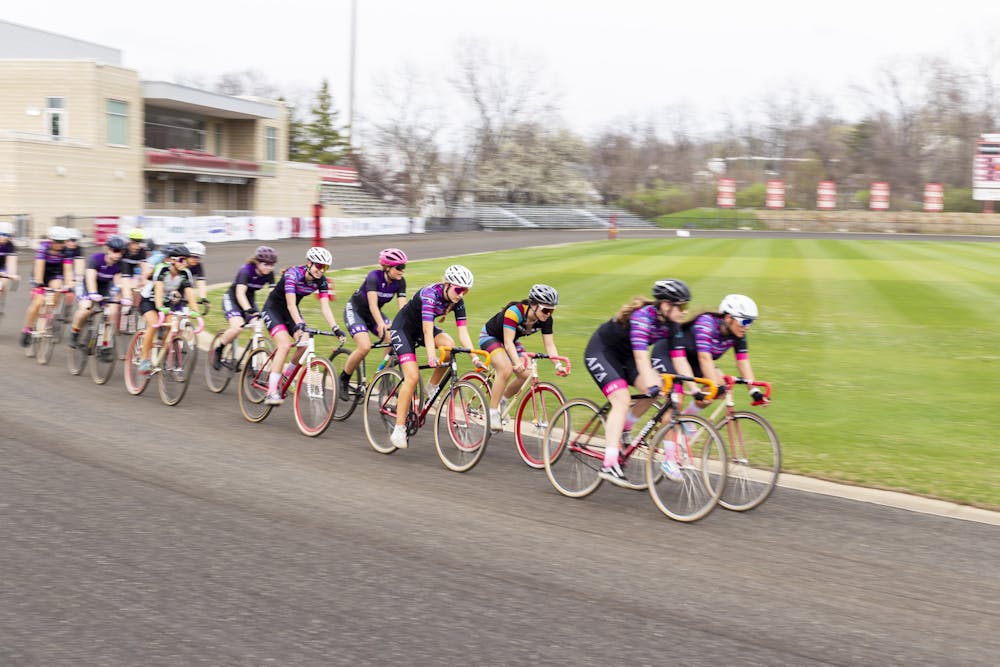“The World’s Greatest College Weekend” is upon us once more.
Last year’s Little 500 was the first race with fans in attendance since 2019, a race that saw Phi Delta Theta victorious in the men’s race and Melanzana Cycling victorious in the women’s race.
This year brings a women’s field that has increased to 27, compared to 22 in 2022. The men’s field is composed of 33 teams, similar to the Indianapolis 500, which is the model for the Little 500.
Alpha Chi Omega will start from the pole position for the 35th women’s race, which lasts 100 laps. The race will take place at 4 p.m. on Friday, April 21.
Cutters, the all-time winningest team with 14 victories, will start the 72nd running of the men’s Little 500 from the pole position. The 200-lap race will begin at 2 p.m. on Saturday, April 22. Both the women’s and men’s races will occur at Bill Armstrong Stadium.
RULES
Pits
Each team has chosen a pit according to its qualification position. Each pit is 16 feet long and along the circumference of the track.
Teams are allowed to have a maximum of six people in their pit on race day — the registered four riders, one credentialed coach and a credentialed undergraduate student coach.
Exchanges
Each team is required to complete exchanges throughout the race. An exchange is where the teams switch riders using one bike or a full-bike exchange using two bikes.
A minimum of 10 exchanges are required for men while a minimum of five are required for women.
The exchanges must be completed within a 32-foot area which is made up of each team’s pit and the pit directly following.
Line-up
All starting riders will be mounted to their bicycles and ready to ride before the pace lap. Riders will be lined up based on the qualification order.
Men’s and women’s qualification orders and jerseys colors can be found on p5.
Penalties
If teams have committed a violation of rules, they will be penalized for a minimum of two seconds. Penalties will be served in the penalty box located near the start/finish line. Penalties must be served within 10 laps of them being issued.
Entering the infield
The cement gutter around the inside of the track is considered part of the infield and shall not be ridden on. If a team is forced onto the gutter and into the infield, they will not receive a penalty and can rejoin the track.
If a team attempts to improve its position by going into the infield, it will receive a minimum penalty of two seconds.
OFFICIALS
IUSF Little 500 Race Director
Emily Carrico is 2023’s race director and is responsible for overseeing all administrative duties and management of the race.
Chief Steward
The Chief steward decides all questions relating to the conduct of the race for which the resolution is not provided in the rulebook. They have the power to disqualify riders for unsportsmanlike conduct and assess penalties.
Judges
Seventeen judges will be stationed around the track and will report irregularities to the chief steward.
Chief Observers
Three observers will be positioned in observation towers to aid the chief steward in the enforcement of the race rules.
Starter
The starter is responsible for waving flags when necessary.
Safety Officials
Safety officials will help to clear the track of accidents, control re-entry to the track, point out infractions to the judges and are responsible for the immediate safety of the riders.
KEY TERMS
Bike
Each team receives two bikes from the IU Student Foundation for race day. The State Bicycle Co. bikes feature a three-piece crankset, which includes a sealed cartridge bottom bracket. The change to a three-piece crankset from a single can level the playing field. Teams will also be able to choose from three bike sizes: 50 cm, 54 cm and 58 cm. In previous years, teams had two options: 56 cm and 52 cm.
Pole
The team that starts the race in first place.
Flags
There are seven flags used throughout the race: green (start), yellow (caution), red (stop), white (one lap until finish), checkered (end of race), black (ride on outside of the track) and blue with an orange stripe (bicycle attempting to pass).
Pack
A group of riders together, usually including the teams near the lead.
Draft
A rider will line up behind another biker, reducing air resistance and allowing the rider to draft — putting in less effort to maintain a speed.
Sprinter
A team’s fastest rider in short bursts, who will often be tasked with the last lap or two to finish the race.
Burn
In preparation for an exchange, the current rider will sprint to separate from the pack before they exchange, “burning” their remaining energy.
Marking
When a team begins a burn, a second team will mark them to pressure them into an exchange to prevent the burning team from faking and creating a lead.
Set
A period of laps a rider spends on the bike before exchanging. Riders with more stamina may ride longer sets, while sprinters will ride shorter and faster sets.
Lapped traffic
Once a team is off the lead lap, they will be directed to the outside of the track as the pack passes them to avoid interfering with the leaders.
Yellow jersey
The winning team from the year before wears a yellow jersey on race day. Last year’s winners were Phi Delta Theta for the men’s and Melanzana Cycling for the women’s.
Green jersey
The team that qualified on the pole wears a green jersey on race day. Cutters placed first in qualifications for the men’s and Alpha Chi Omega for the women’s.
White jersey
The team that won Team Pursuit wears a white jersey on race day. Cutters will be represented in a green jersey because of its pole position for the men’s race. Teter will wear white for the women’s race.
Spring series
A series of four events in the weeks leading up to the race that involve all the riders, including Qualifications, Individual Time Trials, Miss N Out and Team Pursuit. The overall winning team of the Spring Series gets to wear a white bike jersey on race day.
Qualifications
Also known as Quals, a team gets four laps to set a fastest time and qualify within the 33-man Little 500 field. Cutters qualified on the pole for the men’s race and Alpha Chi Omega did so for the women’s race. Both teams will receive a green jersey to wear on race day.
Individual Time Trials
ITTs are also a four-lap event but are completed individually. Four riders compete at the same time, starting in each corner of the track, to complete four laps first. Senior Gavin Goode of the Black Key Bulls finished with the fastest time of 2:24.91 on the men’s side, but the Black Key Bulls were unable to qualify for the Little 500 after being penalized on each of their three attempts in qualifying. On the women’s side, senior Jenna Rodgers of Alpha Chi Omega finished with the fastest time of 2:47.28.
Miss N Out
Starting in heats of five to eight, the last place rider is eliminated every lap until three riders remain. The three advance to the next round until the final heat of eight. Once three riders are left on the last heat, they begin a one-lap sprint to determine the winner. This year’s running was cancelled due to high winds on April 1.
Team Pursuit
Two teams of four start on opposite ends of the track and chase each other down in a pace line for 15 laps. The teams are timed based on the third rider to cross the finish line. The two fastest teams compete to determine the winner. Cutters won the men’s Team Pursuit, while Teter Cycling won the women’s edition.
“Breaking Away”
The 1979 movie about the Little 500 won an Academy Award for best original screenplay. The race team Cutters, who won in 2018 and 2019 and has the most wins in the men’s race with 14, was named after the movie.




